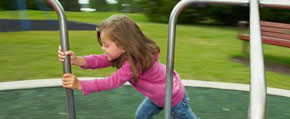Fast Facts
Communities
Parks & Recreation
- Parks with paved trails are 26 times more likely to be used for physical activity than those without. Source
- Children who spent at least 20 minutes a day in greener areas got five times as much physical activity as children who did not. Source
- 81% of mostly Hispanic neighborhoods in three states lacked parks, compared to 38% of mostly White neighborhoods. Source
- Boys were 60 percent more likely to walk for leisure time for every additional park located within a half-mile of their home. Source
Schools
- Teens who are active at school or play sports are 20% more likely to earn an “A” in math or English than sedentary teens. Source
- Kids are very active for at least 50% of their recess period if the playground is painted with lines for recreation. Source
- 28.8% of the Nation’s public and private schools allow the community to use their physical activity spaces and facilities outside of normal school hours. Source
- Cognitive performance is better in girls whose walk to school lasts more than 15 minutes. Source
Transportation
- Walking to and from public transit satisfies the daily physical activity recommendation for 29% of transit users. Source
- Investments in bicycling facilities will save Portland, OR up to $594M in health care costs by 2040. Source
- Children who live near heavy traffic will have a 5% increase in BMI. Source
- States spend just 1.6% of their federal transportation dollars on bicycling and walking. This amounts to just $2.17 per capita. Source
Walking and Biking to School
- Cognitive performance is better in girls whose walk to school lasts more than 15 minutes. Source
STAY UP TO DATE
MOST VIEWED TOOLS & RESOURCES
MOVE! A BLOG ABOUT ACTIVE LIVING
The "Active Living Conference" aims to break down research and practice silos and...
August 14, 2018







